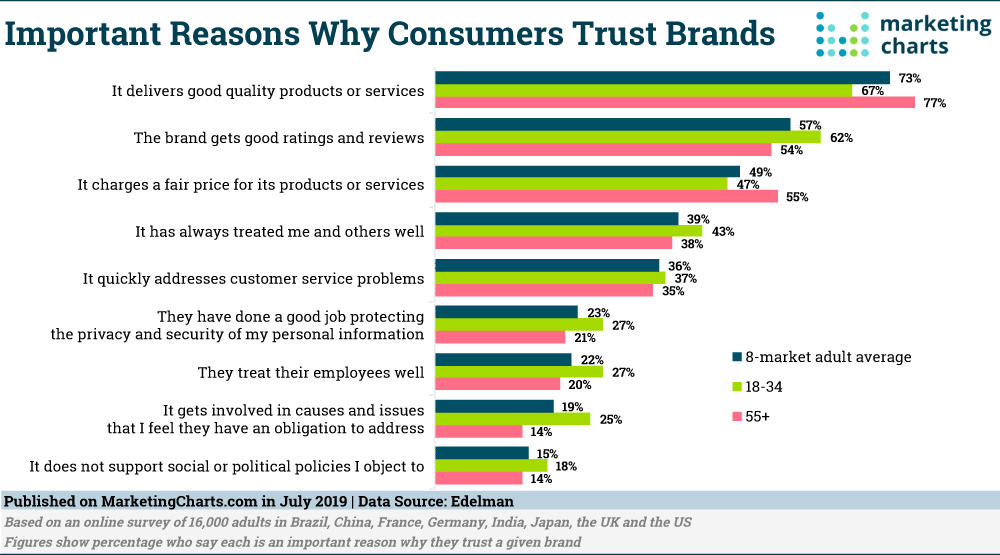These 20 Ecommerce Customer Loyalty Statistics Prove It’s A Critical Component For Success

Exceeding customers’ expectations helps brands stand out and stay ahead of the crowd. To do this right, brands must develop a reputation for reliability and quality products to boost loyalty and trust while building meaningful, solid relationships as part of their strategy to improve customer loyalty and brand trust.
As loyalty programs go mainstream for ecommerce enterprises, maintaining customer connection and engagement and differentiating from the competition is a novel challenge for them. However, they can respond to this dilemma by creating a loyalty-driven consumer experience and improving personalization.
Markets and Markets predicts that the global loyalty management industry with be worth $18.2 billion by 2026. This makes it pivotal for brands to be aware of these statistics to formulate robust strategies.
Let’s take a look into the ecommerce customer loyalty statistics to gauge what metrics are shaping the industry and why customer loyalty is critical to the ecommerce sector.
What Keeps Online Shoppers Loyal?
Loyal customers are the secret to thriving and growing ecommerce brands. These ecommerce customer loyalty statistics show why.
Customers tend to spend more on companies they are committed to, even with other dependable alternatives. They trust a brand that prioritizes customer service and the best product quality from the very start.
With brands offering competing goods and looking to outshine one another, ensuring that your consumers remain loyal to you and coming back is no longer optional.
According to Marketing Charts, the quality of the product or service (77%) tops the list of loyalty drivers, with good ratings and review (62%), fair pricing (55%) and good customer service (37%) following next in line respectively.

Customer Loyalty Statistics for 2022
To help paint a full picture, we’ve curated a list of the essential ecommerce customer loyalty statistics to give you some insightful information that you can use to improve ecommerce customer loyalty and to elevate your brand.
1.) 82% of customers prefer continuing to buy from a company that they trust, even over companies become trendy at that point in time (Marketing Charts).
2.) Customers also value the social proof cues, with about 30% of customers more likely to buy if the online store demonstrates product reviews and ratings from other customers (Fresh Relevance).
3.) 42% of customers prefer purchasing from brands they’ve previously shopped with. While they would switch to some other brand depending on the conditions, 22% of customers would never change to another brand (Fresh Relevance).
4.) 80% of customers consider a seamless experience across channels and product availability anywhere they shop highly important (McKinsey).
5.) The loyalty management market globally was valued at 4.02 billion dollars in 2020 and is expected to reach 13.8 billion dollars by 2026, with a 22.7% annual growth rate (Research and Markets, 2021).
6.) 40% of shoppers admit to shopping at a new business if it offers competitive prices. 35% want to try something new, while 20% like to buy from businesses recommended by friends and family (Fresh Relevance).
7.) 57% of customers are loyal to companies that address societal inequities. (Deloitte)
8.) Interaction experience and product experience significantly impact customer loyalty, accounting for more than 30.4% and 36% shifts in customer loyalty, respectively (Gartner).
9.) 58% of customers like brands to engage with them through gifts and surprise offers. Consumers specified that these surprises are powerful tools for engaging them and making shopping more convenient. These elements have become crucial to loyalty amidst COVID with both the physical and economic challenges resulting from the pandemic (Merkle).
10.) Best-performing loyalty programs can increase revenue from valuable customers who use points by 15% to 25% annually by boosting their basket size, purchase frequency, or both (McKinsey & Company).
11.) Loyal brand advocates and customers (86%) recommend that brand to their family and friends. Customer referral programs are a viable way to offer potential and existing customers incentives, helping the brand build customer loyalty. Shoppers are more likely to increase their purchase frequency if they can earn rewards by referring the brand to their family and friends (KPMG).
12.) 57% of consumers directed that they didn’t switch brands because of the upheavals in 2020. While the misfortunes had a considerable influence on customers’ purchasing behaviors, those who preferred a brand remained loyal regardless of the challenges of the pandemic (Merkle).
13.) 46% of customers stay loyal to a brand even after a poor experience. Customer loyalty is often tried in crucial customer service scenarios. Customer loyalty is more dependent on the overall customer experience. If customers have had a satisfactory experience overall, they are more likely to remain a loyal brand advocates (KPMG).
14.) 45% of consumers stay faithful to their favorite companies because of regular discounts, rewards, and incentives. This is incentivized loyalty. Brands can only reinforce this via targeted incentives related to customers, on the appropriate channel, and at the right time. This drives first-time shoppers to repeat purchases and eventually drives more loyal customers (Emarsys).
15.) 20% of customers are loyal to online retailers that personalize emails depending on the specific customer data (Fresh Relevance).
16.) 44% of brands are more focused on ensuring that their loyalty programs provide a digital experience to customers. And shoppers are more likely to go for a brand if there is a feasibility of accessing the loyalty program across multiple channels without trouble (Mastercard).
17.) Recent customer loyalty statistics highlight that loyal customers appreciate and respect a brand’s efforts to act on their review/feedback. What is more, 90% of peopledecide to purchase products based on their online reviews (Review42).
18.) With one in four shoppers remaining loyal to brands that reward them & make them feel valued, ecommerce businesses need to segment repeat customers. Offer them perks and incentives such as special discounts, early sales access, or a loyalty points program (Fresh Relevance).
19.) 3% of customers became more loyal brand advocates who helped and supported them during the COVID-19 pandemic (Yotpo).
20.) 86% of customers with increased emotional engagement and attachment say that they always think of the companies they’re loyal to when thinking of buying something, and 82% always purchase from the brand whenever they need something (Capgemini).
Wrapping it Up
You have all the reasons to facilitate your customers with unique experiences to boost customer loyalty. And with numerous options surrounding customers today, ecommerce brands need to up their game to stay on top of customers’ minds while keeping them from opting for a competitor’s brand.
By emphasizing emotional loyalty, personalization, loyalty programs, and customer experience, businesses can build a solid bond with their customers and inspire them to become brand advocates.
Whether you plan on relying on user-generated content to improve loyalty or are planning on adding one of a variety of loyalty-improving ecommerce tools to the mix, understanding what drives loyalty in the first place is a great step in the right direction.
So, let these statistics on ecommerce customer loyalty inspire you to level up your marketing game and keep your customers coming back for more.
Need Even More Tips?
Take a look at a few related guides we’ve written that can help you better understand customer loyalty and how you can get the numbers to stack up in favor of your brand. After that, have a look at this infographic on ecommerce customer loyalty statistics we’ve created.
Related Guides:
➡️ Use These Strategies to Increase Customers Loyalty the Easy Way
➡️ How to Maximize Use-Generated Content to Improve Customer Loyalty
➡️ How to Improve Ecommerce Customers Loyalty
➡️ 5 Ecommerce Tools You Can Use to Improve Customer Loyalty

Share On:








